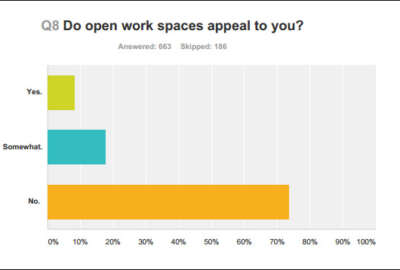Surviving an open office, even with disabilities
Some simple tips and tools can solve most of the problems that employees with disabilities have in open offices. Others can use them too. The story begins below...
Private offices are rapidly disappearing from federal buildings. Cubicle walls have become a rarity in some quarters as employers replace them with shared office spaces. But employees are more wary. Those with disabilities, in particular, say open offices invite distractions that can lower their productivity.
But it doesn’t have to be that way, according to accessibility experts and people with disabilities who have found ways to work in open environments. With creativity and communication, agencies and employees can solve 80 percent or more of the most common problems, said Nadine Vogel, CEO of Springboard Consulting, a firm that has advised agencies on accommodating workers with disabilities.
Employers tend to think that reaching out to employees to discuss disabilities will open a Pandora’s box, she said. One agency client waited until two weeks before moving to begin the conversation, Vogel said. By that time, employees with disabilities had heard rumors. They were panicked about losing their private spaces. One employee asked her if they should hire an attorney.
Early and frequent discussions could have eliminated the concerns, she said.
“People feel comfortable. They have time to think through the process and planning can be done appropriately and effectively,” she said.
Agencies can prepare their new offices with adjustable furniture and other tools that fit a variety of persons’ needs. But they cannot help a particular person unless they disclose that they have a disability, she said. People who move to open offices might need accommodations that they did not in private quarters. Employees should be proactive too, she said.
“Come prepared to suggest things,” Vogel said. “Even to say something like, ‘I have three children and when I’m at home, I use noise-cancelling headphones and I’d like to be able to use those here.’ Even something like that will start a very real dialogue that can impact change.”
Anupa Iyer credits back-and-forth conversations with her boss for helping her find ways to accommodate her disabilities while working in a sometimes-noisy environment. Iyer, an employment lawyer, is the confidential assistant to Commissioner Chai Feldblum of the Equal Employment Opportunity Commission. Hers is the first cubicle one sees upon entering the commissioner’s suite.
It’s a far cry from the open spaces common at other federal offices, like the General Services Administration’s Washington headquarters, which has inspired other agencies to follow suit. But it can get noisy and busy when there are lots of visitors or when people head to the lunch area just across the hall, Iyer said. Her attention-deficit and bipolar disorders amplify the distractions.
When she started working there, Iyer said, she could not focus on her legal research and writing.
“My productivity was not where it needed to be,” she said. “I needed to figure out what I could do to focus and indicate to the other people in the office, ‘Please don’t interrupt me or ask questions.'”
Related Stories
Figuring out how to manage the new environment was “scary” because she wasn’t sure which tools or techniques would work, she said. She turned first to techno music to drown out the noise, a trick she had picked up in law school. But simply wearing headphones confused her colleagues. They were not sure whether they could ask her questions or not. Iyer then used a shared calendar to mark off the time periods when she needed to concentrate.
“That set the stage,” she said. Now she is also trying out colored cue cards from the Autistic Self Advocacy Network. Like a traffic light, the red card signals to others that they should not bother her. The yellow means that they can interrupt her to discuss an important matter or a joint project. Green means, ‘Ask away.’
It also helped to move her computer so that she faced a side wall, rather than the entryway, she said. There are still some days when the noise of the office stresses her, she said. On those days, she asks to go home, or just doesn’t come in to the office at all.
“If I’m doing creative thinking or line editing, working at home can be helpful,” she said. “But being in the space, seeing everyone else do their work, also pushes me.”
Feldblum has given her staff permission to use her private office when she is away. Iyer said she sometimes takes advantage of that, including when she has a telephone appointment with her psychiatrist.
Finding the right accommodations for her disabilities will always be a work in progress that requires collaboration with her colleagues, Iyer said.
“It’s important to have an environment with a supervisor who supports you and is willing to engage in that conversation in a nonjudgmental way,” she said.
Employees often make the mistake of assuming they need a private office to accommodate their disabilities when, as in Iyer’s case, much cheaper and easier solutions are available, said Vogel.
“You can request for anything,” she said. “It doesn’t always mean you need the Cadillac-version answer.”
Accommodations that cost less than $100 can solve common problems in open offices, said Stephen M. King, the director of the Defense Department’s Computer/Electronics Accommodations Program. Noise-cancelling headphones are among the most popular items, but visual accommodations also can help in the open setting.
“Just putting up a simple partition for $100 or so — a screen, drape, curtain, whatever it may be,” he said. “There are basic solutions that would work even in an open environment. We just need to be creative. We need to listen and we need to communicate.”
If that happens, agencies can move employees with disabilities to open offices with very few problems, he added.
Copyright © 2025 Federal News Network. All rights reserved. This website is not intended for users located within the European Economic Area.




